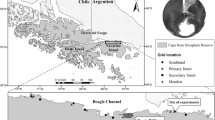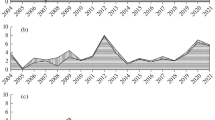Abstract
The paradigm regarding the ecology of populations of small rodents has had several basic theses: (1) the individual has a home range or is a migrant; (2) factors regulating population parameters (including density) include spatio-social relations between individuals; and (3) the phenomena observed on trial plots with a system of live traps are the same as those beyond the plot. However, the home-range concept in small rodents is open to criticism in that: (1) observations point to much greater ranges of spatial activity in these animals than has been shown hitherto in plot-based studies with systems of live traps; (2) there is great variability in the directions and extent of the spatial activity of small rodents; (3) observations suggest that what is regarded as the area of spatial activity of an individual has limited information content since the ‘tenant’ makes use of the area via tracks and trails along which it moves. Transfers of studies on odour-related information in small rodents from the laboratory to natural populations confirm the significance of odours in the life of these animals and in integrating their populations. It is possible that the need to leave information in the environment (informational conditioning) provokes considerable locomotory and spatial activity in small rodents. Live traps with bait (food) limit the spatial activity of animals. The set of traps in which an individual is caught thus represents not home range but trap range. A new paradigm for the ecology of small rodents should comprise the propositions that: (1) the function of olfactory information is the integration of a population into an ecological system; (2) the maintenance of odour-mediated conditioning in the environment is one of the reasons for locomotor and spatial activity; (3) the patchy distribution of food in the environment (including study plots with traps) gives rise to changes in the use made of space by individuals; (4) the phenomena observed on research plots with live traps containing bait are different to those ongoing at the same time outside these areas. Such a paradigm requires reinterpretation of research results obtained hitherto as well as the application of new research methods.
Similar content being viewed by others
References
Andrzejewski R. 1963. Processes of incoming, settlement and disappearance of individuals in the numbers of small rodents. Acta Theriologica 7: 169–213.
Andrzejewski R. 1975. Supplementary food and the winter dynamics of bank vole population. Acta Theriologica 20:23–400.
Andrzejewski R. and Babińska-Werka J. 1986. Bank vole population: are their density really high and individual home ranges small? Acta Theriologica 31: 400–422.
Andrzejewski R., Babińska-Werka J., Liro A., Owadowska E. and Szacki J. 1997. The attractiveness of conspecific and interspecific odour for bank volesClethrionomys glareolus. Acta Theriologica 42: 231–234.
Andrzejewski R. Babińska-Werka J., Liro A., Owadowska E. and Szacki J. 2000. Homing and space activity in bank volesClethrionomys glareolus. Acta Theriologica 45: 155–165.
Andrzejewski R. and Dominas H. 1963. Certain problems of the intensification of ecological methods. Ekologia Polska B 9: 291–298. [In Polish with Enlish summary]
Andrzejewski R. and Mazurkiewicz M. 1976. Abundance of food supply and size of the bank vole home range. Acta Theriologica 21: 237–253.
Andrzejewski R. and Owadowska E. 1994. Use of odour bait to catch bank voles. Acta Theriologica 39: 221–225.
Andrzejewski R., Petrusewicz K. and Waszkiewicz-Gliwicz J. 1967. The trappability ofClethrionomys glareolus (Schreber, 1780) and other ecological parameters obtained by the CMR method. Ekologia Polska A 15: 709–725.
Andrzejewski R. and Wierzbowska T. 1961. An attempt at assessing the duration of residence of small rodents in a defined area and the rate of interchange between individuals. Acta Theriologica 5: 153–172.
Andrzejewski R. and Wierzbowska T. 1970. Estimate of the numbers of traps visited by small mammals based on a probabilistic model. Acta Theriologica 15: 1–14.
Babińska-Werka J. 1990a. Response of rodents to an increased and quantitatively diverse food base. Acta Teriologica 35: 151–156.
Babińska-Werka J. 1990b. Response of bank voles to a new source of food and its withdrawal. Acta Theriologica 35: 191–199.
Bednarz M. 1997. [Presistence of the bank vole odour on polyurethane foam]. MSc thesis, Catholic University of Lublin, Lublin: 1–17. [In Polish]
Bovet J. 1992. Mammals. [In: Animal homing. F. Papi, ed]. Chapman & Hall, London: 321–361.
Bujalska G. 1973. The role of spacing behaviour among females in the regulation of the reproduction in the bank vole. Journal of Reproduction and Fertility 19, Supplement: 463–472.
Bujalska G. 1985. Regulation of female maturation inClethrionomys species, with special reference to an island population ofC. glareolus. Annales Zoologici Fennici 22: 331–342.
Bujalska G. and Hansson L. (eds) 2000. Bank vole biology: recent advances in the population biology of a model species. Polish Journal of Ecology 48, Supplement: 1-234.
Bujalska G. and Saitoh T. 2000. Territoriality and its consequences. [In: Bank vole biology: recent advances in the population biology of a model species. G. Bujalska and L. Hanson, eds]. Polish Journal of Ecology 48, Supplement: 37–49.
Burt W. H. 1943. Territoriality and home range concepts as applied to mammals. Journal of Mammalogy 24: 346–352.
Chitty D. 1960. Population processes in the vole and their relevance to general theory. Canadian Journal of Zoology 38: 99–113.
Christian J. J. 1950. The adreno-pituitary system and population cycles in mammals. Journal of Mammalogy 31: 247–259.
Gliwicz J. and Ims R. A. 2000. Dispersal in the bank vole. [In: Bank vole biology: recent advances in the population biology of a model species. G. Bujalska and L. Hanson, eds]. Polish Journal of Ecology 48, Supplement: 51–61.
Górecki A. and Gębczyńska Z. 1962. Food conditions for small rodents from the deciduous forest. Acta Theriologica 6: 275–295.
Grodziński W. 1963. Can food control the numbers of small rodents in the deciduous forest. [In: Proccedings of the XVI International Congress of Zoology, Washington, D.C., 20–27 August, 1963]. 257.
Grodziński W. and Petrusewicz K. 1983. Contribution of bank voles to the functioning of forest ecosystems. [In: Ecology of the bank vole. K. Petrusewicz, ed]. Acta Theriologica 28, Suppl. 1: 207-213.
Grodziński W., Pucek Z. and Ryszkowski L. 1966. Estimation of rodent numbers by means of prebaiting and intensive removal. Acta Theriologica 11: 297–314.
Hansson L. 1977. Spatial dynamics of field volesMicrotus agrestis in heterogeneous landscape. Oikos 29: 539–544.
Kozakiewicz M. and Szacki J. 1995. Movements of small mammals in a landscape: patch restriction or nomadism. [In: Landscape approaches in mammalian ecology and conservation. W. Z. Lidicker Jr, ed]. University of Minnesota Press, Minneapolis: 78–94.
Kuhn T. S. 2001. Struktura rewolucji naukowych [Polish translation: The structure of scientific revolution. Third Edition. The University of Chicago Press 1996.]. Aletheia, Warszawa: 1–169.
Lidicker W. Z. Jr 1975. The role of dispersal in the demography of small mammals. [In: Small mammals: their productivity and population dynamics. F. B. Goley, K. Petrusewicz and L. Ryszkowski, eds]. International Biological Programme, Vol. 5. Cambridge University Press, Cambridge, Great Britain: 103–134.
Marchlewska-Koj A. 2000. Olfactory and ultrasonic communication in bank voles. [In: Bank vole biology: recent advances in the population biology of a model species. G. Bujalska and L. Hanson, eds]. Polish Journal of Ecology 48, Supplement: 11-20.
Mazurkiewicz M. 1969. Ellyptical modification of the home range pattern. Bulletin de L’Academie Polonaise des Sciences, Serie des siences biologiques Cl. II 17: 427–431.
Mironov A. D. and Kozhevnikov W. C. 1982. Character of migrations ofClethrionomys glareolus within the home range and outside it. Zoologicheskii Zhurnal 61: 1413–1418. [In Russian with English summary]
Osipova O. Y. and Rutovskaya M. V. 2000. Information transmission in bank voles by odour and acoustic signals (signalling communication). [In: Bank vole biology: recent advances in the population biology of a model species. G. Bujalska and L. Hansson, eds]. Polish Journal of Ecology 48, Supplement: 21–36.
Owadowska E. 1999. The range of olfactory familiarity between individuals in a population of bank vole. Acta Theriologica 44: 133–150.
Pelikán J. 1971. Quadrat size and density estimation of small mammals. Zoologicke Listy 20: 139–152.
Pelikán J., Zejda J. and Holiošova V. 1972. Influence of prebaiting on the catch of small mammals. Zoologicke Listy 21: 209–225.
Petrusewicz K. 1963. Population growth induced by disturbance in ecological structure of the population. Ekologia Polska A 3: 87–125.
Petrusewicz K. 1978. [Individual, population, species]. Państwowe Wydawnictwo Naukowe, Warszawa: 1–384. [In Polish]
Petrusewicz K. (ed) 1983. Ecology of the bank vole. Acta Theriologica 28, Suppl. No. 1: 1-242.
Petrusewicz K. and Andrzejewski R. 1962. Natural history of a free living population of house mice (Mus musculus Linnaeus) with particular reference to grouping within the population. Ekologia Polska A 10: 85–122.
Rajska-Jurgiel E. 2001. Movement behaviour of woodland rodents: looking from beyond small trapping grids. Acta Theriologica 46: 145–159.
Rajska-Jurgiel E. and Mazurkiewicz M. 2000. ‘Single-capture’ rodent vagrants or just newly weaned young? Acta Theriologica 45: 485–490.
Rall J. M. 1936. Movement characteristics of murid rodents within small plots. Zoologicheskii Zhurnal 51: 472–482. [In Russian with English summary]
Sherwin C. M. 1998. Voluntary wheel running: a review and novel interpretation. Animal Behaviour 56: 11–27.
Stenseth N. C. and Lidicker W. Z. Jr (eds) 1992. Animal dispersal. Small mammals as a model. Chapman & Hall, London: 1–365.
Stoddart M. D. 1974. The role of odour in the social biology of small mammals. [In: Pheromones. M. C. Birch, ed]. North-Holland Publishing Company, Amsterdam: 297–315.
Stoddart M. D. 1980. The ecology of vertebrate olfaction. Chapman and Hall, London: 1–231.
Wierzbowska T. 1972. Statistical estimation of home range size of small rodents. Ekologia Polska 20: 781–831.
Wynne-Edwards V. C. 1962. Animal dispersion in relation to social behaviour. Oliver and Boyd, Edinburgh: 1–653.
Author information
Authors and Affiliations
Rights and permissions
About this article
Cite this article
Andrzejewski, R. The home-range concept in rodents revised. Acta Theriol 47 (Suppl 1), 81–101 (2002). https://doi.org/10.1007/BF03192481
Received:
Accepted:
Issue Date:
DOI: https://doi.org/10.1007/BF03192481




